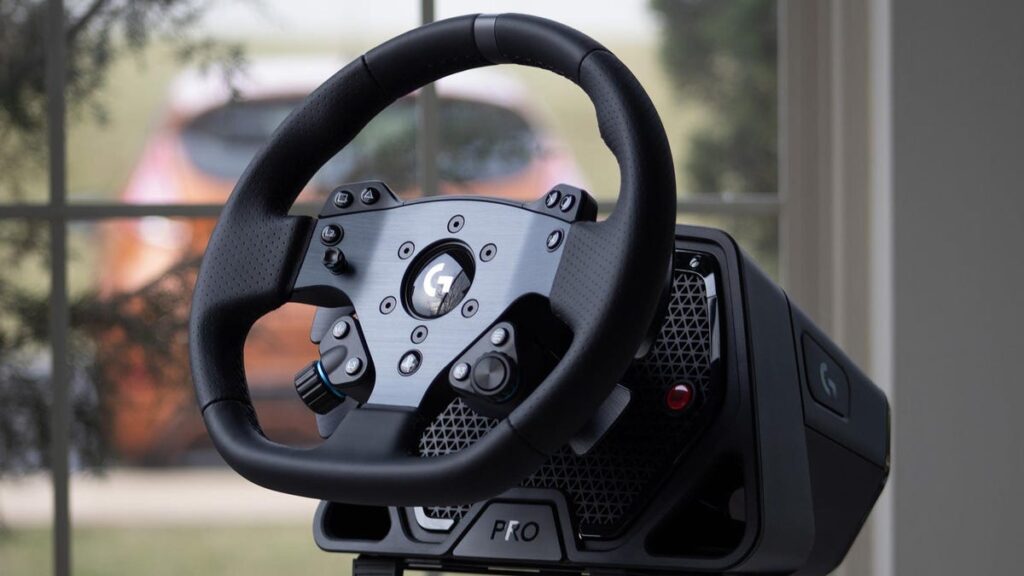Logitech’s G Pro Direct Drive Wheel and Load Cell Pedals Are the Real Deal, And Really Pricey

Photo: Adam Ismail
Fifteen years ago, you’d have told anyone getting into sim racing to just buy a Logitech wheel. That’s what I did; that’s what my friends did. But a lot can change in a decade and a half, and while Logitech’s bread-and-butter G29 and G923 wheels are still an excellent choice for casual players or those just looking to dip their toes into the hobby, they’re far from the last word. This little hobby has come a long way.
That’s why the $999 Logitech G Pro Racing Wheel is such a big deal. It not only uses the company’s first direct drive system, it’s Logitech’s first wheel base not driven by gears. The accessories giant skipped over belt-equipped wheels altogether, and at last, Logitech hardware is in the conversation again – and better for it.
Full disclosure: Logitech provided me with a G Pro Racing Wheel ($999) and Racing Pedals ($349) which include a load-cell brake. The wheel I tested was the PlayStation- and PC-compatible version; there’s another model that swaps PlayStation support for Xbox.
Compatibility, Pricing and Availability
Both the Logitech G Pro Racing Wheel and Racing Pedals are available now and sold separately. They also aren’t cheap: The wheel costs $999 while the pedals will set you back $349. The Racing Wheel comes with a base and rim, though Logitech hasn’t confirmed whether alternative rims will be available. Both components utilize a quick-release mechanism, however, suggesting other designs may be offered eventually. At the time of writing, the wheel and pedals are in stock at Logitech’s U.S. site and ready to ship.
G/O Media may get a commission

Up to $100 credit
Samsung Reserve
Reserve the next gen Samsung device
All you need to do is sign up with your email and boom: credit for your preorder on a new Samsung device.
Design
Photo: Adam Ismail
Some sim racers will cry sacrilege here, but I don’t need the steering wheel on my rig to look exactly like one in a real car. Material quality is far more important for me, as are ergonomics, both for driving and navigating menus. Logitech has always executed both pretty well, and the Pro wheel and pedals are no different.
First off, I love that the rim is circular. Rectangular or squircle wheels are great if all you do is road racing, but load up Dirt Rally and you’d sooner sprain your wrists than finish a stage. The rim itself is lined in grippy, perforated faux-leather, while the spokes are made of metal. Everything feels solid and built to withstand the peak 11 Newton-meters of torque this base is capable of, which won’t be a surprise to anyone rocking old-school Logitech gear. This stuff can really take a beating.
The setup’s dials feel nice and weighty, too, as do the paddles on the back of the wheel. The paddles aren’t as clicky as the ones on, say, the G923, nor are they the solid, see-saw block of milled metal like what you’ll find on the back of Fanatec’s McLaren GT3 V2 formula rim. I got accustomed to the heft of these paddles over time, just as I did on the McLaren equipment. Still, snappier plates would result in quicker shifts and make me feel quicker, too.
Photo: Adam Ismail
Overall, the G Pro wheel’s design makes thumbing around Gran Turismo 7’s menus a piece of cake, and I appreciate the tiny, four-way stick that makes for a serviceable replacement for a dedicated D-pad for front-end navigation. I’m not as much of a fan of the unique positioning of the left rotary dial, however, even though Logitech says the “thumb sweep” orientation was refined with suggestions from sim racers.
The idea here is that you don’t need your thumb and index finger to turn this dial, which means you can keep your left hand on the wheel as you make on-the-fly adjustments. In GT7, for example, both dials are mapped to the game’s multi-function display for adjusting fuel maps, traction control and the like. That’s a great idea in concept, but the dial is just out of reach for me when I hold the wheel in the usual 9-and-3 position. Maybe my thumbs are freakishly small or something. Your mileage may vary.
The “thumb sweep” dial on the left side of the G Pro Racing Wheel rim can be awkward to manipulate, although the thought behind the design is a good one.Photo: Adam Ismail
Critics will bemoan the use of plastic on the bases of the wheel hub and pedals, but Logitech’s material feels about as premium as it possibly can, and not at all flimsy. In fact, the pedal set is so heavy that I didn’t even need to secure it to my Wheel Stand Pro. That’s not to say this doesn’t present problems; the footprint for the wheel base is considerably larger than my stand’s Logitech-compatible mounting plate, so I could only screw it into two of the plate’s four M6 screw holes. Fanatec’s compact CSL DD base is far more amenable to space-conscious setups, and easier to universally hard mount to any rig thanks to its ingenious sliding T-nut design.
The quick release mechanism that joins the rim with the wheel base is a snap to operate.Photo: Adam Ismail
Speaking of which, Logitech still generously supplies a table clamp for anyone brave enough to mount 11 Nm of direct-drive torque straight to their office desk. My desk has a keyboard tray, so that’s not an option for me. Also, one final point of praise goes to the wheel base’s display, which offers a surprising degree of personalization for both steering and pedal behavior without the need to mess with Logitech’s PC software. You can adjust everything from this screen, from peak torque to Logitech’s TrueForce haptics to max brake pressure — crucial when dialing in sensitivity on a load cell pedal. Of course, you can also make mechanical adjustments to each pedal; more on that later.
Steering and Force Feedback
Photo: Adam Ismail
You buy a direct-drive steering wheel for its feeling of immediacy, fidelity and quiet, notch-free smoothness. The G Pro certainly delivers on this promise.
It might not feel that way out of the box, though. I predominantly used my tester with GT7 on the PS5, and I had to fiddle with both the hub’s built-in settings as well as the game’s before I could turn laps in comfort. For example, by default the wheel was programmed to utilize only 5 Nm of force out of the available 11 Nm, and Gran Turismo’s default settings left the feedback feeling too light and clumsy for my liking.
That changed once I increased the in-game values for max torque and sensitivity. The former simply made the motor more powerful while the latter ramped up the frequency of those intrusions of feedback, resulting in a more present, engaging drive. I only needed about 7 Nm, and I knew I found the right formula when I was able to feel the wheel get light at the peak of Road Atlanta’s infamous esses, before catching the slide just in time over the wide outside curb. Once you’re dialed in, you’ll have a blast with this kit.
Speaking of curbs, this brings me to one of the G Pro’s other standout features: TrueForce. This is Logitech’s proprietary technology for conveying haptics, in addition to force feedback, through its wheels. It debuted in the entry-level G923, and while I was ambivalent of its inclusion there — the wheel felt like it was buzzing all the time, regardless of the car’s status — I like it much more in the G Pro’s repertoire.
On the back of the G Pro Racing Wheel base you’ll find one Micro USB port, three USB-A ports and a standard AC adapter port. The lack of USB-C is a little surprising considering the high price, though it doesn’t really make a difference in usability.Photo: Adam Ismail
With TrueForce, you’re better able to feel the vibrations of rumble strips at track limits, or that teeth-clenching judder of understeer in a front-wheel-drive car. It gives you more information to use while driving, and that’s always a good thing. Besides, if you’d rather do without it, TrueForce can always be turned off. I wouldn’t necessarily choose the G Pro over an equivalent Fanatec direct-drive build for TrueForce alone — it relies on developer support on a game-by-game basis, after all — but it’s a nice bonus.
G Pro Racing Pedals
Here you can see the included alternative springs for the throttle and brake, as well as the optional elastomers for the load-cell brake pedal.Image: Logitech
With sim rigs, a proper set of pedals can be as important as the wheel base. To that end, Logitech offers a set of three pedals equipped with a load-cell brake in addition to its direct-drive wheel for another $349. Unlike most budget pedals or those that have come pre-packaged with Logitech wheels in the past, these are far more robust and adjustable.
For starters, you can reposition each pedal’s plate on its post to allow more or less lateral room between them. The entire pedal assemblies themselves can be slid on their rails, too. Hell, the seriously hardcore can even detach those modules from their plastic base and fix them to a tube-frame rig or whatever sim racing furniture you can imagine. It’s a welcome commitment to customization that typically isn’t seen from big peripheral makers like Logitech.
Photo: Adam Ismail
Of course, the biggest draw here is the load cell behind the brake. A load cell is very desirable in a brake pedal because it measures pressure applied rather than distance traveled. It also tends to increase the resistance of the pedal’s action. The more force required to push the pedal down, the more range available to finely modulate your braking intensity. With a load cell, it’s much easier to locate that optimal degree of pressure to maximize your stopping power without pressing too hard and creating a nice, big flat spot on your tires.
As I said earlier, I love that the display on the wheel hub allows you to set a max pressure value, which will likely be different for every player depending on their setup. Pedals fixed to a metal frame backbone can certainly withstand more abuse than an unfastened set under a desk, for example.
Removing the load cell to change out the rubber inside is very easy, and simply requires you to unscrew the blue dial and pull the piston back and out.Photo: Adam Ismail
One of the other wonderful things about load cells is that you can typically adjust their resistance through the use of different foam blocks or other hardware inside the piston. To Logitech’s credit, the company provides a few elastomer pieces of ranging hardnesses with every set of Racing Pedals, along with springs for the throttle and clutch. That’s very handy, but Fanatec actually had an ingenious solution to this problem with its old ClubSport V3 set: a “preload screw” that, when turned, made the brake firmer or softer. For my needs, I was able to tweak the ClubSport V3’s brake to my preference just by twisting that screw, no disassembly required.
While Logitech’s product does have a similar looking dial, this part only exists to remove the load cell so you can change the parts inside it — not for on-the-fly fine tuning. It’s a disappointing oversight that keeps these pedals just shy of perfection.
Value and Verdict
Photo: Adam Ismail
The direct-drive market is heating up, and that means that sim racers eager for a step up in hardware have a choice to make. You can opt for Fanatec’s CSL DD kit — provided you can even get your hands on one — or Logitech’s new products. Thrustmaster has its own solution on the way in the form of the $650 T818, but at the moment, that one’s relegated to PC only. There are also brands like Simucube and VRS, catering to discerning pros willing to drop $1,300 or more on a base alone.
For most people, then, the big debate comes down to Logitech versus Fanatec. And the answer really is quite simple. If you can nab a Fanatec CSL DD set, do it. The bundle with the Gran Turismo rim, load-cell triple-pedal set and force feedback Boost Kit (to unlock the full 8 Nm the CSL DD is capable of) is currently priced at $970, with pre-orders live for the next batch and availability slated for the end of February. Additionally, if you want to swap out your base’s rim for something different down the line or grab a few for different types of driving, Fanatec has a wide selection already on offer, and it’s still unknown what Logitech’s G Pro ecosystem will look like.
I recommend the CSL DD not because it’s better than Logitech’s option, but because it’s about as good and considerably cheaper, especially if you’re shopping for a wheel, base and pedals as a complete set.
That’s not to say Logitech doesn’t have its advantages, of course. The build quality is a touch nicer, the G Pro wheel can churn out even more torque for those who want that and, frankly, I have more confidence in Logitech’s reliability over the long term, as well as its customer support. Ultimately, though, you can’t make a wrong decision here — go with what’s in stock and what you can afford. What a great, expensive time it is to be a sim racer.





